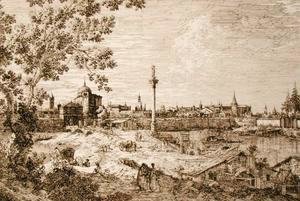Canaletto: Master Drawer and Etcher
There is no doubt that Canaletto was a brilliant artist and his drawings and etchings are so perfect it was believed that he had traced the images in some way, perhaps using a camera obscura.
The Royal Collection Trust has a wonderful collection of Canaletto drawings and etchings sold to King George III by Consul Smith. Let's have a look at some of these remarkable images created in the mid 1700s.
Below is a pen and ink work completed in about 1734. There are traces of free and ruled pencil and pinpointing is evident.

This is one of a set of eight views on the Grand Canal. Each is a tour de force of penwork, the water dashed in with vigorous horizontal scribbles and the buildings shaded with strict diagonal hatching; only the treatment of the sky varies from drawing to drawing, ranging from light clouds blocked in with simple diagonals, to the graduated cross-hatching seen at its most dense to the right here. The drawings were not made on the spot, but carefully constructed in the studio from a number of open-air sketches from different vantage points, including those on the pages of a sketchbook now in the Accademia, Venice.1
Here are two further examples of Canaletto's pen and ink sketches of buildings, close up, so you can see the incredible details he was able to execute.


It has been revealed that the Italian painter Giovanni Antonio Canal, also known as Canaletto, did not trace his works (as previously believed), and in fact sketched them with a pencil and ruler. Back in 1771, the artist’s biographer wrote that he used a camera obscura to trace some of his key art works - a claim that has been disputed by art enthusiasts for centuries. However, according to the Royal Collection Trust and thanks to the latest infrared technology, it has been confirmed that the works were instead sketched by Canaletto....2
The Royal Collection Trust found that the technique used by the artist was pencil on carbon paper. This was revealed by infrared light and showed the original sketch underneath the final pen and ink masterpiece. Rosie Razzall, curator of prints and drawings, said: “We thought it would be fruitful to look at it under infrared and we were just amazed by the results. You get this image of Canaletto’s meticulous underdrawing, as he really, really carefully plans out the sheets with pencil and ruler. “It’s fascinating from that point of view, and also for its wider significance. It shows very clear that he wasn’t using a camera obscura to make these drawings.” The works identify the extensive underdrawing of the Venetian buildings, from detailed chimneys to facades, as well as how Canaletto used a ruler to outline reflections in the water. Experts can now confirm that the Italian artist copied over the pencil lines with ink and he then added in details like birds, clouds and ripples on the water with a free hand.2
Yesterday we looked at some of Canaletto's capriccio and he extended this mode of creation to his drawings. The image on the left (below) is totally imaginary whereas on the right Canaletto has taken the north part of the façade of San Marco, and placed it on a quay approached by wide steps, surrounded by the waters of the lagoon. One of the lions from the Piazzetta dei Leoni has been set among fragments of architecture on a rough shore in the foreground; another lion has been placed on the steps of the basilica. In the distance is a city with fanciful towers and a tiered mausoleum. 1


Canaletto's skill at drawing was also used to great effect in his etchings.

Canaletto and his nephew Bernardo Bellotto began to experiment with etching in the early 1740s, an enterprise that has often been attributed to the decline in visitors to Venice and commissions following the War of Austrian Succession. Many of Canaletto's prints take their subject matter from the locks, sluice gates and summerhouses along the Brenta Canal towards Padua; others are entirely imaginary. Canaletto made just thirty-three etchings in total.1

After the image has been etched the artist applies ink to the plate with a dauber. Too much pressure will flatten the burrs and ruin the image. Once the plate is completely covered with a thin layer, a tarlatan cloth (open-weave muslin) is used to wipe away excess ink. Once the desired amount of ink is removed, the plate is run through an etching press along with a piece of dampened paper to produce a print.4
Here are two more examples of Canaletto's etchings.


Credits
- rct.uk
- cadogantate.com
- canalettogallery.org
- en.wikipedia.org
